Menus
- The three-wheeler at a low price
- Discovery
- In the saddle
- Contact
- In the city
- Highway
- Departmental
- Comfort
- Braking
- Convenient
- Daily
- Consumption
- Revisions
- Conclusion
- Accessories
The three-wheeler at a low price
Three-wheeled scooters have experienced tremendous growth, especially in France since the appearance of the Piaggio MP3 which has just taken impressive market shares, especially on the entire 125 cm3 category, enough to give ideas to other manufacturers, including Quadro then today Yamaha. However, Yamaha announces that it does not want to compete with the MP3 with a model that is much lighter and more intended for women and first-time buyers, or even to be shared with the whole family. After a notable success with xx sales in 2014, the Tricity declined in a Tryptik version at MBK, arrives in 2015 with an ABS version. The opportunity to test it and compare it with its version in combined braking.
Discovery
Three wheels…. this is arguably the first obvious characteristic of the Tricity, compared to a majority of scooters – again – two-wheeled in the traditional way. The second rests on the flat floor – usually only present on models with large wheels – of the model which contrasts with the usual massive center bridges. Compared to the usual MP3, we mostly find a very small scooter, almost closer to a 70 cm3 than a 125 cm3. And the figures are there to confirm this impression with a narrower axle of 385mm against 465 for the MP3, a wheelbase of only 1310 mm and a featherweight for the category of 152 kilos empty (156 kilos for the ABS version). Even the Yourban Piaggio is almost a juggernaut next to it. Then we find a specific Yamaha line, which is ultimately not so far from the concepts of the 01-Gen and 03-Gen brand..
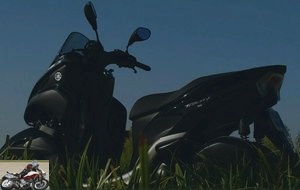 Yamaha Tricity side
Yamaha Tricity side
Curvy, the scooter draws a pretty slender and elegant line from front to back, with a discreet exhaust. We appreciate the well-designed front face underlined by a headlight and a series of LEDS overhung by a pretty bubble. The aluminum rims with the 6 worked spokes reinforce the design aspect of the whole. Only the almost massive rear light stands out noticeably in the overall picture. Available in four colors – white, black, gray / anthracite, red, it is undoubtedly the red color that offers the most beautiful paint. The finish is up to Yamaha then, well finished down to the smallest detail.
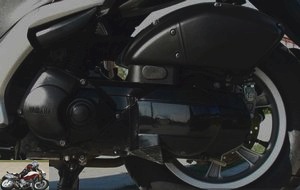 Single cylinder 4T 2 valves 124.38 cm3 Yamaha Tricity
Single cylinder 4T 2 valves 124.38 cm3 Yamaha Tricity
In the saddle
With a flat floor, there is no need to step over and you naturally sit down with plenty of space under your feet. Note the hook for the parcel rack, thus making it possible to block any more or less imposing bag capable of fitting under the feet. With a saddle height of 780mm, the 1.70m rider almost puts his feet on the ground, almost because the saddle remains wide. But the light weight, rather low, puts you at ease immediately. The handlebars fall naturally under the hands, offering a perfectly natural position.
The eyes then fall on a particularly readable fully digital dashboard, including a fuel gauge, rarely present on the 125 cm3. Close to a GS or car chart more generally, there is a huge meter, added to a huge clock on the left and the outside temperature on the right. The central gauge allows you to know at any time where you are at the consumption level.
Then we find the more usual partial double trip and totalizer and less usual the odometer for the belt and the oil change..
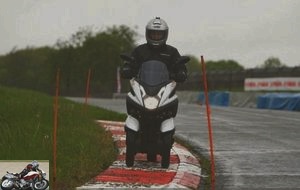 Yamaha Tricity test on bumpy pavement
Yamaha Tricity test on bumpy pavement
Contact
The 4-stroke, 2-valve, single-cylinder, electronically injected, gently snorts. No steering lock or roll-lock here and we therefore lift the scooter on its stand. The reaction to the right grip is instantaneous and the scooter takes off smoothly. What is surprising is the ease of handling, which is really instinctive. When the three wheels usually cause a certain heaviness in the front axle, the Tricity never makes it feel, so much so that you almost think you have a two-wheeler in your hands. And yet, the wider axle does feel more downforce and greater stability. It’s without a doubt Yamaha that struck the perfect balance between providing stability without compromising agility. And this agility is found from the first few meters, whether it is to go down or up a sidewalk or to pass over a vertical drop leading to the front wheels at different levels.
In the city
Gentle on acceleration, the Tricity is characterized above all by its incredible agility, especially on slow maneuvers at very low speeds between cars. The maneuvers are done without thinking about it, without feeling the weight of the front axle and on the contrary by benefiting from it, for passages between the cars at right angles, without even feeling the need to put the foot on the ground, as is often the case. case with a two-wheeler when you are really very slow. In fact, the Tricity helps pass through mousholes perfectly with an agility it wasn’t as obvious, especially when you’re used to three-wheelers with a much heavier front end..
 Test between baffles in Yamaha Tricity
Test between baffles in Yamaha Tricity
Narrow, the scooter then weaves its way naturally between the lines of cars, in the same way as a 125cc two-wheeler. The mirrors are positioned at the right height to offer both a good view and without ever obstructing a passage, however narrow it may be..
The braking is then up to the inclinations of the machine, with all the necessary power, especially at the end of the lever. The first few centimeters are hardly noticeable in efficiency and the power comes next. And when you take the levers fully, you stop quickly and hard and without blocking, even in the non-ABS version! The Tricity has specific combined mechanical braking via a cable connecting the right lever and the left lever. The pressure on the left lever therefore causes a slight grip of the right lever also, thus significantly facilitating the grip of the brake and especially its efficiency. And in the dry, well launched in a straight line at 80 km / h and even taking the two levers fully, the Tricity remains in line, to stop quickly and well, without beginning to slide. You really have to take only the rear brake (which drives a little but not 100% the front brake) and brake by forcing the brake on to start hearing a start to lock. In fact, even with "reflex" braking, you don’t take the brake so violently unless you have super-trained athletic hands..
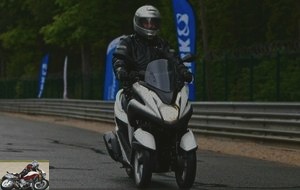 Yamaha Tricity ABS brake
Yamaha Tricity ABS brake
With its light weight, the Maxxis tires are not strained and hold the pavement very well in the dry and have not caused the start of sliding in the wet, under normal conditions of use. And for those who want to ride with a more all-season brand adapted to our latitudes, they will soon be able to turn to a Michelin CityGrip fitment which should be available within a few months..
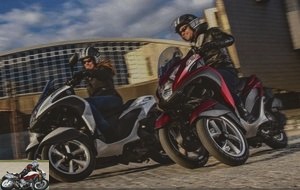 Yamaha Tricity in town
Yamaha Tricity in town
Highway
The Tricity takes off gently on the motorway, gradually picking up speed from 80 km / h. It is then able to drive at 100 km / h, odometer, on average. Well launched, in a straight line, with a slight slope and the wind at your back, it is even capable of posting a 109 km / h odometer, which is a good real 101 km / h. But as soon as the road becomes false flat, it goes down to around 95 km / h, or even as soon as it begins to rise significantly and over a little length at 85 km / h. The motorway is definitely not his favorite terrain. However, it offers excellent stability, even when you are overtaken by trucks. On a Paris-Beauvais, which we did, the average is more suddenly around 85 km / h, solo. We note the limit of 8.1 kW, compared to the 10.55 kW of an XMax, or almost 30% less power at the same engine speed, and we can feel it. We will therefore prefer more of the national, or even the departmental.
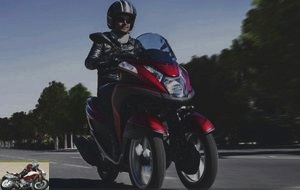 Yamaha Tricity road test
Yamaha Tricity road test
Departmental
The Tricity gladly finds the departmental roads from which it allows you to enjoy the landscapes in peace. The handling is really there with the reinforcement of stability which makes it possible to consider blind turns with confidence, without fear of a bumpy or particularly slippery road. Intuitive, it allows you to easily recover a little optimism, not to mention that you are rarely too fast, to get back to the rope point without thinking about it. Far from widening when cornering, it just goes naturally where its driver is looking.
The only flaw of a three-wheeler would almost ultimately be that it gives more self-confidence than a two-wheeler. And you may have to take a quicker turn or be tempted to take a corner with more angle than you would with a two-wheeler. However, the front axle of the Tricity is narrower than other three wheels and three wheels never means, whatever the model of three-wheeler, the impossibility of falling.
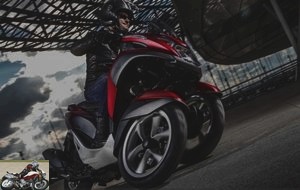 Yamaha Tricity test on departmental
Yamaha Tricity test on departmental
Comfort
When you know the XMax 125, the Tricity is particularly comfortable, helped by a saddle and a suspension that work very well. It is then in the high average of the comfort provided, solo. As a duo, the suspensions quickly come to a stop and comfort decreases a notch.
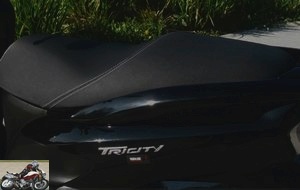 Yamaha Tricity saddle
Yamaha Tricity saddle
Braking
Some manufacturers are abandoning their excellent combined braking in favor of ABS. Yamaha retains its UBS coupled braking at the three discs AND adds ABS. There is also a 220mm dual disc up front and a 230mm rear disc. And as much as ABS is often justified on many two-wheelers, it must be said that the Yamaha coupled braking is simply excellent with real comfort and safety on a daily basis. The feeling of just taking the lever is not great at first, but the reaction to the grip is very effective after passing the first guard. You can usually lock the rear wheel under heavy braking, and that’s almost impossible with combined braking, even when using the brakes like a trapper. ABS, also tested in the rain, is a plus in poor grip conditions. And indeed, launched at 80 km / h, with a pad to mark the start of braking, successive braking can undeniably shorten the final braking distance by several meters. Better, while we often have a return / recall of the lever bouncing in the hand, we hardly feel the ABS come into action. The scooter stays perfectly in line and the braking really gives you self-confidence. Finally, with an original balance between the front and the rear (50% at the front and 50% at the rear), the Tricity hardly gets off the ground on big, steep turns but on the contrary remains practically horizontal.
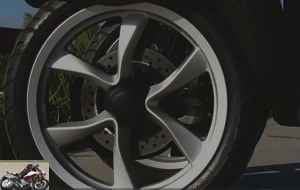 UBS integral braking on Yamaha Tricity
UBS integral braking on Yamaha Tricity
Convenient
There is no forward box at the front. And under the saddle, there is a mini-trunk designed to accommodate a modular, even as big as a C3. Then we won’t put on anything else. In fact, the main advantage comes from the flat floor, which can accommodate a huge bag, or even allow the single person to do their weekly groceries..
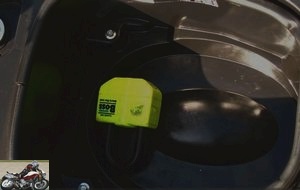 Case for a modular Yamaha Tricity helmet
Case for a modular Yamaha Tricity helmet
Daily
There is no steering lock or parking brake. On the other hand, there is a side stand, really practical in everyday life. It sits easily underfoot and unfolds naturally when stopped. In the event of a slope, we prefer the central stand, also available, not to mention the fact that the Tricity is really easily put on the central stand..
Consumption
The fuel gauge is very precise, with a big stick that goes down roughly every 30 kilometers, more or less quickly depending on the right grip. We arrive at half the gauge between 85 and 105 kilometers. And then we fall on the reserve in nervous mode, handle toc, after 160 kilometers. The last stick then flashes, as the reserve trip begins to increment, indicating the number of kilometers traveled since the reserve pass. The average consumption thus turns around 3.4 liters per hundred with an average range of 190 kilometers, or even 200 kilometers at most for those who preserve their engine with a very smooth driving, thanks to the small tank of 6.6 liters..
Revisions
The first service is normally carried out after 1,000 kilometers. All the others are carried out by checks every 4,000 kilometers with a first major overhaul with a first oil change at 12,000 km and a larger one with the change of the V-belt at 20,000 km.
Conclusion
Lightweight, reassuring with the additional stability provided by its three wheels, easy to handle, the Tricity is the scooter to share with the family, depending on the needs. Not too powerful, it will not scare novices and reassure them on a daily basis, even and including in the rain. Pure bikers who want a 125, but a punchy 125, will be frustrated by its limited power which will then make them rather turn to the XMax of the same displacement offering much more nervousness. Its good transport availability with the flat floor makes it a plus to also transform it into a utility vehicle on a daily basis. Finally, its line will seduce women with an elegant and practical device. Best of all, the Tricity is the cheapest of the three-wheeler at ‘just 3,999 euros (4,499 with ABS), roughly the same price as an XMax. A flat floor price which makes it more than excellent value for money, a real opportunity in the now competitive three-wheel segment.
Strong points
- three wheels
- UBS integral braking (even better in ABS)
- price quality
Weak points
- engine power
The Tricity technical sheet
Accessories
- High windshield: Price: 179,00 €
- Sport screen Price: € 69.40
- Handguards Price: 69.40 €
- Passenger backrest support Price: € 109.00
- Passage backsplash cushion Price (gold stitching): € 53.20
- Comfort seat Price (black / gray): € 248.00
- Top case support Price (black): € 99.20
- 39-liter City top-case Price (unpainted black): € 144.00 Price (black – SMX): € 170.00
- Colored covers for 39-liter City top-case Price (black – unpainted): € 20.59 Price (black – SMX): € 40.50
- Interior bag for 39-liter City top-case Price 0 (black): € 42.90
- Universal barrel for City top case Price: € 15.49
- Passenger backrest for 39-liter City top-case Price (black): € 46.30
- Footboard plates Price (aluminum): € 64.50
- GPS bracket Price (black): € 39.70
- Tucano Apron Price (black): € 119.00
Related articles
-
MP3 killer? 5 day trial… Xmax Blu-Core single cylinder, UBS full braking, 14 wheels, Bridgestone tires, Smart Key, tilt lock… How to give confidence…
-
Alone in the world Single cylinder VVA of 124 cm3, 15 hp and 11.5 Nm, 140 kg full made, 4,599 euros Today, when you want to ride a vintage / retro /…
-
Yamaha Tricity and Nmax scooter comparison
Yamaha upgrades its Urban Mobility scooter offer to Euro 4 standard Common BlueCore engine on these two models In life, there are existential questions:…
-
Yamaha XMax 250 maxi-scooter test
In the XMax family, I ask … the father! Declination of the TMax in smaller, the XMax is especially the father or the big brother of the XMax 125. Same…
-
Yamaha TMax 560 TechMax maxi-scooter test
Standard vs TechMax: which model to choose ? Twin cylinder of 562 cm3, 47.6 hp and 55.7 Nm, 218 kg, from 11,990 euros 7th generation! Yes the Yamaha TMax…
-
2015 vintage Thirteen years since the TMax made its appearance with several major evolutions since the TMax 500 cm3. If the maxi scooter evolves again in…
-
Yamaha Bulldog BT 1100 biker test
Biker tests: François Contact Ordered on photos, without having seen it except on the internet, you have to be crazy. But so much worse, I let go, I…
-
Mini-size, maxi-pleasure Who would have said that a 125 cm3 mini scooter had its place in France? We were used to aggressive scooters with small wheels….
-
Master Transform 125cc VAA single cylinder, A S clutch The 125, it is young people with the A1 license and B licenses who do not want to take the…
-
The scooter missing between 250 and 530 cm3 in tune XMax 125, XMax 250, TMax 530…. one could have imagined that Yamaha would go hunting on the roads of…